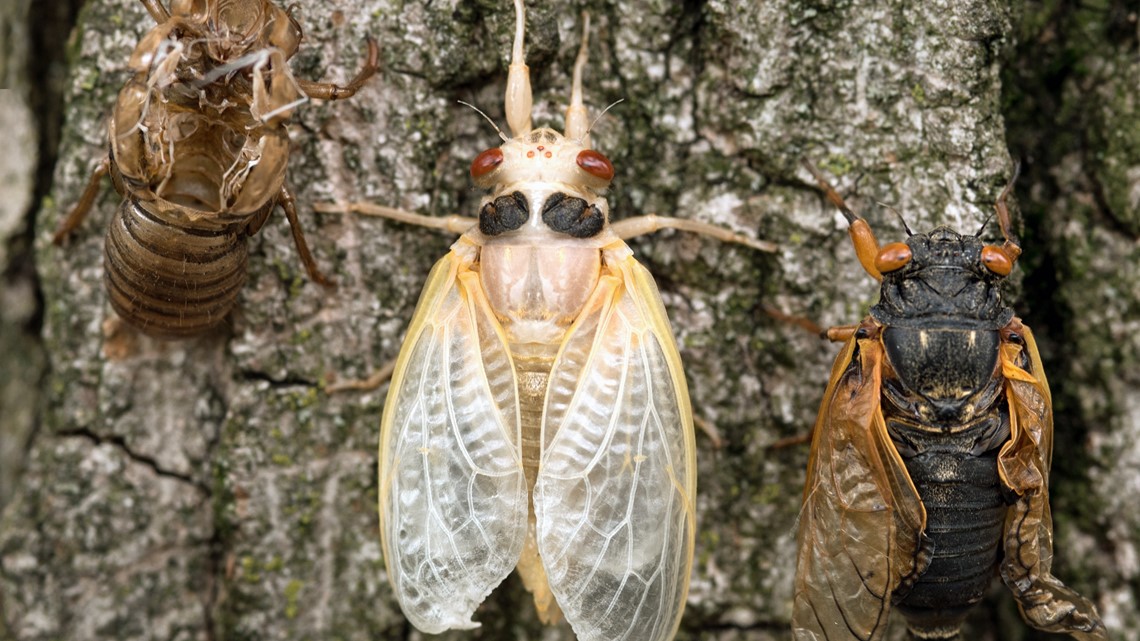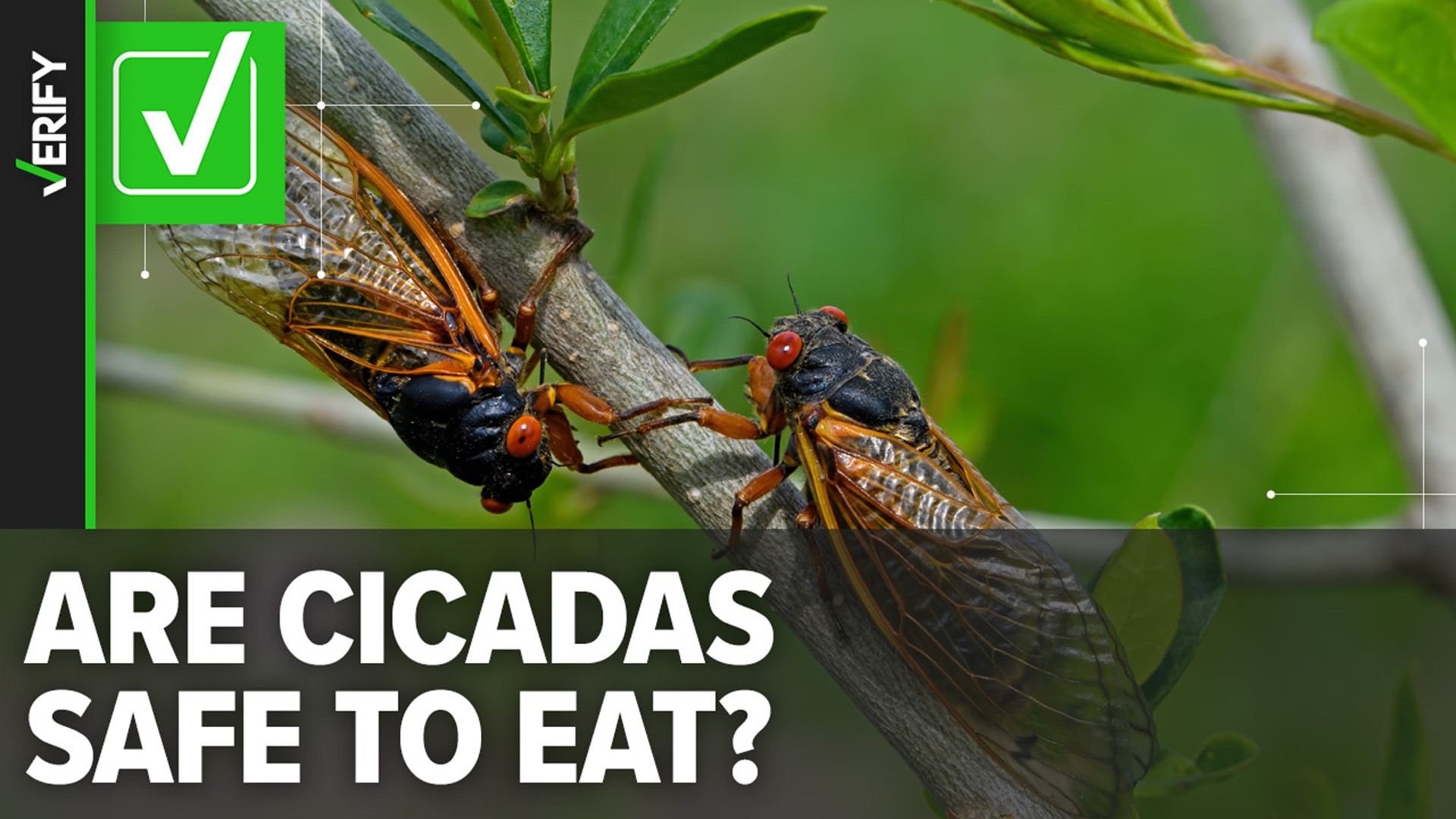There are 15 broods of periodical cicadas in the eastern and central U.S., each one on a different 13-year or 17-year life cycle. In 2024, two such broods will emerge: the 13-year Brood XIX, primarily in the southern U.S., and 17-year Brood XIII, primarily in Illinois and its surrounding states.
As cicada season approaches, many people on social media are talking about the insects’ edibility. Some people claim the periodical cicadas are edible, while others say they are not.
THE QUESTION
Are cicadas safe to eat for people and pets?
THE SOURCES
- American Kennel Club (AKC)
- Mercy Health, a hospital system in Ohio and Kentucky
- Floyd Shockley, Ph.D., collections manager for the National Museum of Natural History
- Montclair State University news article with quotes from Cortni Borgerson, Ph.D., a university anthropologist
- Ohio State University’s College of Food, Agricultural, and Environmental Sciences article with quotes from David Shetlar, Ph.D., a university entomologist
THE ANSWER
Yes, cicadas are safe to eat for people and pets. However, people with shellfish allergies should not eat them, and people should be careful not to eat any of the infected "zombie" cicadas.
WHAT WE FOUND
Cicadas are edible, particularly after they first emerge and have yet to molt. However, cicadas can be harmful to people with shellfish allergies and shouldn’t be eaten by people or pets if they are infected with the yellow Massospora fungus.
“Fresh, unsprayed cicadas are fine for human consumption (cleaned and cooked) and relatively safe for pets (so long as they don’t overdo it),” said Floyd Shockley, Ph.D., collections manager for the National Museum of Natural History.
Your pet might like eating cicadas a little too much, so you may have to monitor your furry friend to keep them from eating more cicadas than they can handle.
“Dogs in particular, like to eat them,” Shockley said. “They're nontoxic, so they're not going to be poisoning your pet. But what happens often, especially in dogs, is that they're eating to the point that they don't realize that they've eaten too much, and it will upset their stomach, but it's totally safe.”
The American Kennel Club (AKC) says your dog will be fine after eating a few cicadas. However, if your dog eats a large amount of them then it can suffer serious consequences because the cicadas’ exoskeletons will be difficult to digest.
A dog might have severe stomach upset and abdominal pain, vomiting, and bloody diarrhea if it eats too many cicadas, the AKC says. Some dogs may require intravenous fluids, pain medications, gastroprotectants, or anti-nausea drugs.
But in more moderate amounts, and when prepared properly, cicadas are both safe to eat and rich in nutrients. Shockley said there’s documentation that Native Americans even used them as a food source at times.
“They're really high in protein, they're relatively low in fats, especially the sort of high cholesterol fats, so they're actually a relatively nutritious food source. If you can get past the fact that you're eating a cicada,” Shockley said.
People also have trouble with cicada exoskeletons, so experts recommend that anyone who wishes to eat cicadas harvest the insects before their shells have a chance to harden. The best time to search for them is right after dusk and on trees once they start emerging. If you see one that’s pale white and has only just grown its wings, you’re looking at a cicada without a hardened exoskeleton that’s ripe for plucking, wrote Cortni Borgerson, Ph.D., anthropologist for Montclair State University, in a university news article.


At that point, you grab them, put them in a bag and then freeze them for about 30 minutes before preparing them. You should wash the cicadas thoroughly before attempting to prepare them, too, says Ohio State University’s College of Food, Agricultural, and Environmental Sciences.
Montclair State University says anywhere you’d feel safe keeping a garden is likely safe to pick cicadas from. Shockley said they’re not safe for consumption by people or pets if you’ve tried to spray them with pesticide.
David Shetlar, Ph.D., an entomologist at Ohio State University, told the university’s College of Food, Agricultural, and Environmental Sciences that it’s important to cook cicadas or any other insects collected in the wild and avoid eating them raw.
“While there is little risk of any dangerous pathogens or parasites to be found in cicadas, there is always the slim risk of picking up something that you certainly don’t want to get by eating the cicadas raw,” Shetlar said.
Cicadas can be fried or roasted, or even dipped in chocolate, according to Mercy Health, a hospital system in Ohio and Kentucky. Shockley said cicadas generally work well with any recipe that calls for shrimp.
“You have to remove the wings and the legs before you prepare them,” Shockley said. “But it's really easy to do and you can flash freeze them. So you're not plucking them off while they're still alive or anything.”
However, there are certain cicadas you shouldn’t try to grab and eat: those infected with the Massospora cicadina. An infected cicada will have the back half of its body replaced with a yellow, powdery “plug.”
“Those are not palatable for human or animal consumption as the fungus produces a number of hallucinogenic compounds (psilocybin, amphetamine) as well as a bunch of other compounds that are not good for you,” Shockley said. “It also makes the cicada taste bitter. The fungus wants the host cicada to infect as many cicadas as possible, and so it discourages predators from eating it until it has spread the spores as widely as possible by making it taste terrible.”
This story is also available in Spanish / Lee este artículo también en español: Sí, es seguro para tu mascota y para tí consumir cigarras

